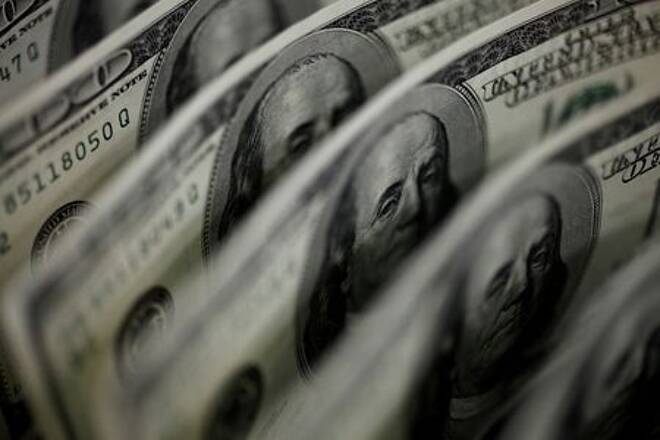Advertisement
Advertisement
Dollar Edges Higher as Treasury Yields Inch Up
By:
NEW YORK (Reuters) - The dollar edged higher on Wednesday, helped by U.S. Treasury yields recovering from one-week lows and as concerns about the economic impact of COVID-19 lingering in Europe led investors to show a preference for the U.S. currency.
By Jessica DiNapoli and Ritvik Carvalho
The dollar index, which touched a four-month high earlier in the session, was supported by safe-haven flows as some investors fretted over potential U.S. tax hikes.
The dollar rose against a basket of currencies to 92.5210. Yields on the 10-year Treasury rose a bit to 1.642% but stayed below recent highs as investors looked ahead to an auction on Wednesday.
“We’re kind of sideways right now,” said Ronald Simpson, managing director, global currency analysis, at Action Economics. “The euro hit a four-month low against the dollar. The rise in COVID in Europe is getting out of control again.”
Euro-dollar was down 0.25% at $1.1820 on Wednesday.
“Meanwhile U.S. Treasury yields have gone up quite dramatically and have been supportive of the dollar,” Simpson said.
The overnight flight to safety got an additional nudge when Treasury Secretary Janet Yellen told lawmakers that future tax increases will be needed to pay for infrastructure projects and other public investments.
Yellen and Federal Reserve Chair Jerome Powell are also scheduled to testify to the Senate Banking panel on Wednesday.
Euro zone business activity unexpectedly grew this month, a preliminary survey showed, but with much of Europe suffering a third wave of coronavirus infections and renewed lockdown measures, that may not last through April.
IHS Markit’s flash composite PMI, seen as a good guide to economic health, climbed above the 50 mark separating growth from contraction, to 52.5 in March compared with February’s 48.8, its highest since late 2018.
The index that measures the dollar’s strength against a basket of peer currencies is up nearly 3% year to date, confounding widely held expectations among analysts for a decline.
Strategists at BCA Research said they believe the U.S. dollar is experiencing a “counter-trend rally within a bear market.”
“Over the near-term, the dollar benefits from two supports. First, the U.S. growth will outperform thanks to generous fiscal policy and the country’s lead in vaccinations. Second, the NASDAQ and other highflying global equities have been correcting since February, creating some risk-off undertones that help the counter-cyclical greenback.”
“However, real interest rate differentials will ultimately determine the currency’s cyclical outlook. The Fed’s commitment to maintaining an accommodative policy will cap upside to U.S. real rates at the short end of the curve. This will prevent a sharp appreciation in the dollar.”
Human rights sanctions on China imposed by the United States, Europe and Britain, which prompted retaliatory sanctions from Beijing, added to market concerns overnight.
The safe-haven yen rose 0.32% in morning trading in the United States.
Australia’s dollar – considered a liquid proxy for risk – weakened further on Wednesday. The Aussie slipped to as low as $0.7582, a level not seen since Feb. 5., before recovering.
The British pound weakened as far as $1.3675, also the lowest since early February.
In cryptocurrencies, bitcoin gained 4.11% to $56,503, off a record high of $61,781.83
(Reporting by Jessica DiNapoli and Ritvik Carvalho; additional reporting by Kevin Buckland in Tokyo; editing by Larry King)
About the Author
Reuterscontributor
Reuters, the news and media division of Thomson Reuters, is the world’s largest international multimedia news provider reaching more than one billion people every day. Reuters provides trusted business, financial, national, and international news to professionals via Thomson Reuters desktops, the world's media organizations, and directly to consumers at Reuters.com and via Reuters TV. Learn more about Thomson Reuters products:
Did you find this article useful?
Latest news and analysis
Advertisement
